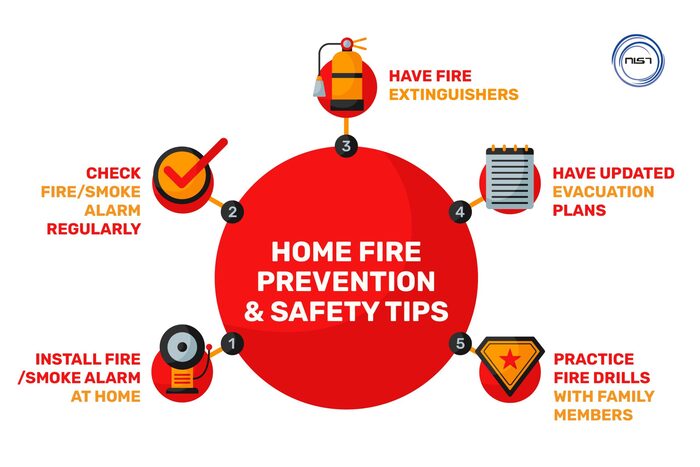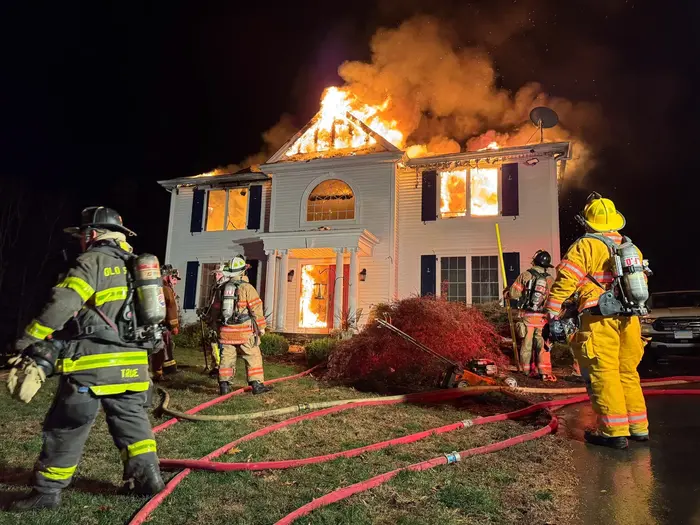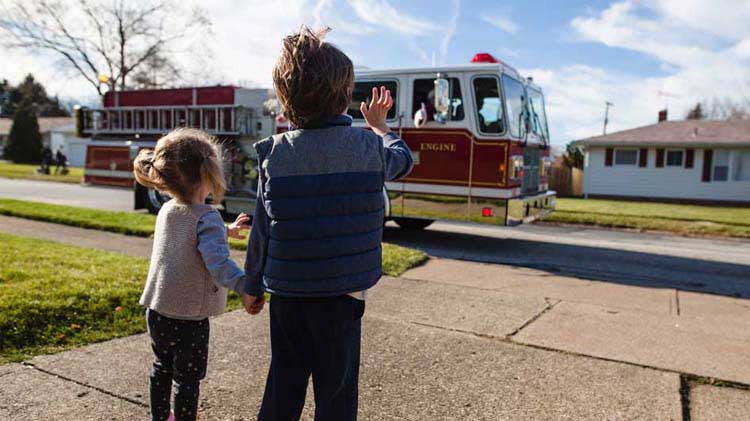Homeowner Fire Safety | PASS – Imagine this: a quiet evening at home, the aroma of dinner wafting from the kitchen, children playing in the living room, and suddenly, the unmistakable scent of burning plastic. Panic sets in as you realize an electrical fire has ignited. Such scenarios are alarmingly common, with electrical fires causing over 50,000 home fires annually in the United States, leading to approximately 500 deaths and $1.3 billion in property damage.
Key Takeaways:
- Install Smoke Alarms: Ensure smoke alarms are present on every level of your home, inside bedrooms, and outside sleeping areas. Test them monthly and replace batteries as needed.
- Create an Escape Plan: Develop a home fire escape plan with at least two ways out of every room and a designated meeting place outside. Practice it twice a year.
- Avoid Overloading Circuits: Do not overload electrical outlets or extension cords. Plug major appliances directly into wall outlets.
- Inspect Electrical Cords: Regularly check cords for damage. Replace frayed or cracked cords immediately.
- Use Appropriate Light Bulbs: Ensure light bulbs match the recommended wattage for lamps and fixtures to prevent overheating.
Understanding Home Fire Risks
Electrical fires often stem from faulty wiring, overloaded circuits, or the misuse of electrical devices. Recognizing these hazards is the first step toward prevention.
Common Causes of Electrical Fires:
- Faulty Wiring: Older homes may have outdated wiring that can’t handle modern electrical loads, increasing fire risk.
- Overloaded Circuits: Plugging too many devices into a single outlet or extension cord can cause overheating.
- Damaged Cords: Frayed or cracked cords can expose wires, leading to short circuits and fires.
- Incorrect Bulb Wattage: Using bulbs with higher wattage than a fixture recommends can cause overheating.
Fire Prevention Strategies
Preventing electrical fires requires vigilance and adherence to safety practices.
Electrical Fire Safety Tips:
- Regular Inspections: Have a qualified electrician inspect your home’s wiring, especially if it’s over 20 years old.
- Avoid Overloading Outlets: Distribute electrical devices across multiple outlets to prevent overloading.
- Use Extension Cords Sparingly: Extension cords are for temporary use. If you need more outlets, have an electrician install them.
- Proper Light Bulb Usage: Always use bulbs that match the recommended wattage for your fixtures.
- Unplug Unused Devices: Disconnect appliances and electronics when not in use to reduce fire risk.
- Install Arc-Fault Circuit Interrupters (AFCIs): These devices detect dangerous arcing conditions and shut off power to prevent fires.
- Educate Family Members: Ensure everyone knows how to use electrical devices safely and the importance of not overloading circuits.
Detection and Alarms
Early detection of fires is crucial for safe evacuation.

Smoke Detectors:
- Installation: Install smoke alarms on every level of your home, inside bedrooms, and outside sleeping areas.
- Maintenance: Test alarms monthly and replace batteries at least once a year. Replace the entire unit every 10 years.
- Wireless Options: Consider wireless smoke detectors that can interconnect, so when one alarm sounds, they all do.
Carbon Monoxide Detectors:
- Importance: Carbon monoxide is a colorless, odorless gas that can be deadly. Install detectors outside sleeping areas and on every level of your home.
- Maintenance: Test monthly and replace batteries as needed. Replace units according to the manufacturer’s guidelines.
Fire Alarm Systems:
- Advanced Systems: Consider installing a comprehensive fire alarm system that includes smoke and carbon monoxide detectors, heat sensors, and can alert emergency services.
Escape Planning
In the event of a fire, having a well-rehearsed escape plan can save lives.
Creating a Fire Escape Plan:
- Draw a Floor Plan: Sketch your home’s layout, marking two exits from each room.
- Designate a Meeting Point: Choose a safe spot outside where everyone will gather after escaping.
- Practice Regularly: Conduct fire drills at least twice a year, including during nighttime.
- Consider Special Needs: Assign someone to assist young children, elderly family members, or those with mobility issues.
- Teach Fire Safety: Educate all family members on how to crawl low under smoke, check doors for heat before opening, and stop, drop, and roll if clothing catches fire.
Fire Escape Ladders:
- Upper Floors: If bedrooms are on upper levels, invest in fire escape ladders and ensure everyone knows how to use them.
Fire Suppression Tools
Having the right tools can help control small fires before they escalate.
Fire Extinguishers:
- Types: Different extinguishers are designed for different fire types.
Fire Extinguisher Type Suitable For Fires Involving Class A Ordinary combustibles like wood, paper, cloth Class B Flammable liquids like grease, gasoline, oil Class C Electrical equipment and appliances Class D Combustible metals Class K Cooking oils and fats (commonly used in commercial kitchens) - Placement: Keep extinguishers in accessible locations, such as the kitchen, garage, and near exits.
- Usage: Learn the PASS technique
When it comes to fire prevention, a proactive approach saves lives. This section delves into essential practices, advanced systems, and family safety strategies to ensure your home and loved ones are protected.
Fire Safety Checklist
Creating and adhering to a fire safety checklist ensures consistent vigilance. Below are actionable steps to minimize risks:
- Inspect Wiring Regularly: Hire a licensed electrician to inspect your home’s wiring every 10 years.
- Keep Flammable Items Away from Heat Sources: Maintain at least three feet of clearance around heaters and stoves.
- Check Electrical Appliances: Unplug appliances when not in use and replace damaged cords immediately.
- Store Combustibles Safely: Keep flammable liquids like paint or gasoline in proper containers and away from heat.
- Avoid Extension Cord Overuse: For permanent needs, install additional outlets.
Raising Fire Safety Awareness
Fire safety education is an investment in peace of mind. Teaching children about fire risks and precautions builds a safer environment for everyone.
- School Programs: Many local fire departments offer school visits to discuss fire safety.
- Community Outreach: Attend local workshops or seminars focused on fire safety (Ready.gov).
- Home Drills: Regularly practice evacuation scenarios to reinforce learning.
Fire Detection & Maintenance
An effective fire safety plan includes devices that detect dangers early. While smoke detectors are standard, expanding your system increases safety.
Smoke Alarm Installation Best Practices
- Install smoke alarms inside every bedroom, outside sleeping areas, and on every floor.
- Avoid installing near windows, doors, or ducts where drafts could interfere with operation.
- Test alarms monthly and replace the batteries yearly.
Wireless Smoke Detectors
Wireless systems offer interconnected safety. If one detector senses smoke, all connected alarms will activate, providing quicker alerts throughout the home.
Carbon Monoxide Detectors
Carbon monoxide poisoning claims hundreds of lives annually. Installing CO detectors in sleeping areas and on every floor ensures early detection.
Escape Planning: Practice Makes Perfect
When smoke fills the air, a well-rehearsed plan is your best defense. Family fire plans need to cover all scenarios, from blocked exits to nighttime evacuations.
Key Components of a Fire Escape Plan
- Escape Routes: Identify two exits for every room, including windows.
- Meeting Point: Select a safe location far from the home, like a neighbor’s yard or mailbox.
- Practice Fire Drills: Conduct drills during the day and at night. Include unexpected scenarios to simulate real emergencies.
- Emergency Communication: Ensure everyone knows how to call 911.
Fire Escape Ladders
For multi-story homes, fire escape ladders are non-negotiable. Store them in accessible areas and practice deploying them with family members.
Specific Fire Hazards to Address
Kitchen Fire Safety
Cooking accidents remain the leading cause of home fires. Reduce risks by:
- Staying in the kitchen when cooking.
- Keeping flammable items like towels and pot holders away from the stove.
- Using timers to prevent unattended cooking.
Electrical Fire Safety
Electrical systems are a silent danger. Tips for staying safe:
- Never force plugs into outlets.
- Avoid running cords under rugs or furniture.
- Replace outdated circuit breakers with modern safety features like Ground Fault Circuit Interrupters (GFCIs).
Heating Fire Safety
Space heaters and fireplaces are winter staples but also major hazards:
- Place space heaters on flat, nonflammable surfaces.
- Keep fireplaces clean and equipped with a sturdy screen.
Candle Fire Safety
Candles bring ambiance but can ignite fires in seconds. Reduce risks by:
- Using flameless LED candles.
- Keeping candles at least 12 inches from flammable materials.
- Extinguishing candles when leaving the room.
Smoking Fire Safety
Smoking materials are a leading cause of fatal home fires. To stay safe:
- Smoke outside.
- Use deep, sturdy ashtrays.
- Douse cigarette butts with water before disposal.

Fire Suppression Systems
Fire Extinguishers
Knowing the right extinguisher and how to use it can stop small fires before they escalate.
| Fire Type | Appropriate Extinguisher | Examples of Use |
|---|---|---|
| Class A | Water, foam | Paper, wood, fabric |
| Class B | CO2, dry chemical | Gasoline, oil, grease |
| Class C | Dry chemical, CO2 | Electrical fires |
Fire Extinguisher Usage (PASS Method):
- Pull the pin.
- Aim the nozzle at the base of the fire.
- Squeeze the handle.
- Sweep side to side.
Home Fire Sprinklers
Home sprinkler systems are often overlooked but can save lives and reduce property damage significantly. Modern sprinklers are affordable, easy to install, and highly effective.
Common Myths About Fire Safety
- Myth: “Smoke alarms are enough.” Fact: Smoke alarms detect fires, but suppression tools like extinguishers and sprinklers are crucial for containing them.
- Myth: “I’ll smell the smoke.” Fact: Smoke can incapacitate quickly, and many fires occur during sleep.
- Myth: “Small fires can’t spread fast.” Fact: A small flame can engulf a room in under five minutes.
Frequently Asked Questions (FAQs)
How often should smoke alarms be replaced?
Smoke alarms should be replaced every 10 years, regardless of functionality.
What’s the best fire extinguisher for a home?
A multi-purpose extinguisher labeled ABC is ideal for most home applications.
Can pets be included in a fire escape plan?
Absolutely. Assign someone to retrieve pets or ensure they are trained to exit safely.
Where should I install a fire sprinkler system?
Sprinklers should cover high-risk areas, including kitchens, garages, and living spaces.
How do I teach kids fire safety?
Use interactive resources and practice drills to make learning engaging (Oregon.gov).

